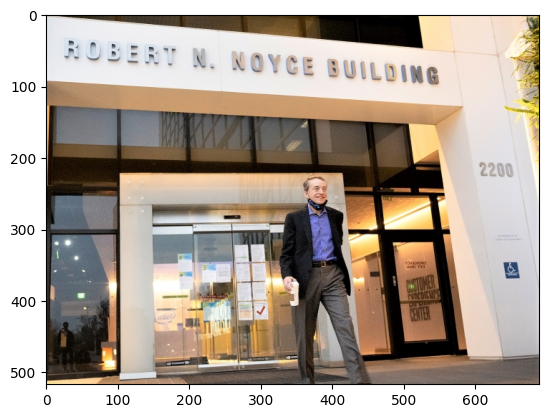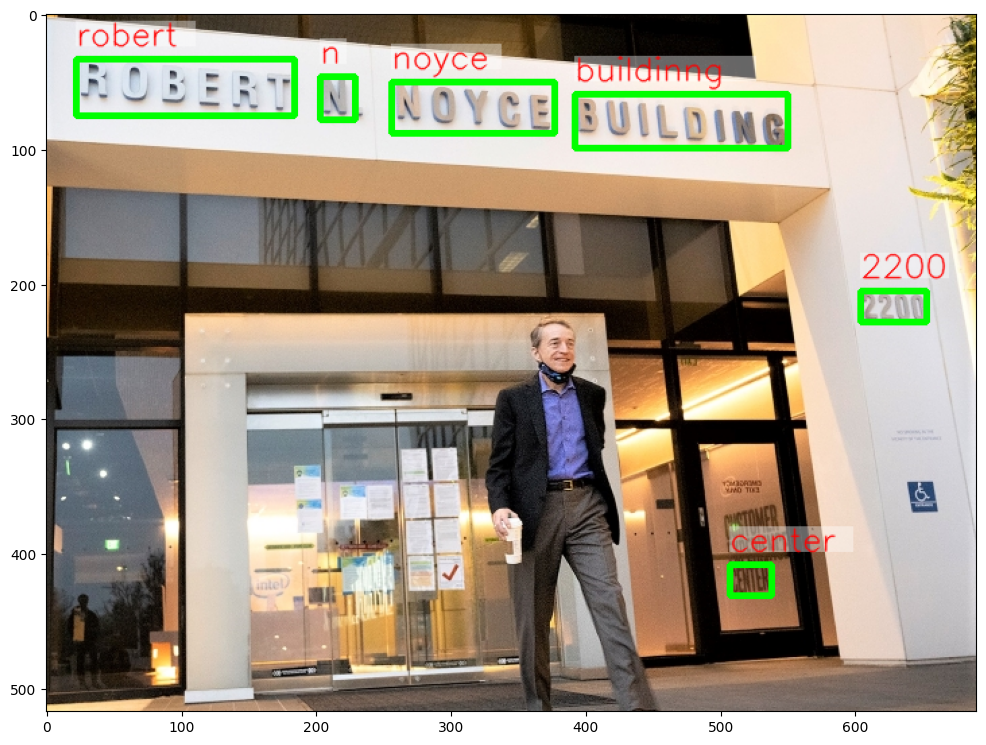Optical Character Recognition (OCR) with OpenVINO™#
This Jupyter notebook can be launched on-line, opening an interactive environment in a browser window. You can also make a local installation. Choose one of the following options:
This tutorial demonstrates how to perform optical character recognition (OCR) with OpenVINO models. It is a continuation of the hello-detection tutorial, which shows only text detection.
The horizontal-text-detection-0001 and text-recognition-0014 models are used together for text detection and then text recognition.
Table of contents:
Installation Instructions#
This is a self-contained example that relies solely on its own code.
We recommend running the notebook in a virtual environment. You only need a Jupyter server to start. For details, please refer to Installation Guide.
# Install openvino package
%pip install -q "openvino>=2024.4.0" pillow opencv-python "matplotlib>=3.4"
Imports#
from pathlib import Path
import cv2
import matplotlib.pyplot as plt
import numpy as np
import openvino as ov
from IPython.display import Markdown, display
from PIL import Image
# Fetch `notebook_utils` module
import requests
if not Path("notebook_utils.py").exists():
r = requests.get(
url="https://raw.githubusercontent.com/openvinotoolkit/openvino_notebooks/latest/utils/notebook_utils.py",
)
open("notebook_utils.py", "w").write(r.text)
from notebook_utils import download_file, device_widget
# Read more about telemetry collection at https://github.com/openvinotoolkit/openvino_notebooks?tab=readme-ov-file#-telemetry
from notebook_utils import collect_telemetry
collect_telemetry("optical-character-recognition.ipynb")
Settings#
core = ov.Core()
model_dir = Path("model")
precision = "FP16"
detection_model = "horizontal-text-detection-0001"
recognition_model = "text-recognition-0014"
model_dir.mkdir(exist_ok=True)
Download Models#
The next cells will download the detection and recognition models. If the models have been downloaded before, they will not be downloaded again.
from notebook_utils import download_ir_model
detection_model_url = f"https://storage.openvinotoolkit.org/repositories/open_model_zoo/2023.0/models_bin/1/{detection_model}/{precision}/{detection_model}.xml"
recognition_model_url = (
f"https://storage.openvinotoolkit.org/repositories/open_model_zoo/2023.0/models_bin/1/{recognition_model}/{precision}/{recognition_model}.xml"
)
detection_model_path = model_dir / detection_model / precision / f"{detection_model}.xml"
if not detection_model_path.exists():
detection_model_path = download_ir_model(detection_model_url, model_dir / detection_model / precision)
recognition_model_path = model_dir / recognition_model / precision / f"{recognition_model}.xml"
if not recognition_model_path.exists():
recognition_model_path = download_ir_model(recognition_model_url, model_dir / recognition_model / precision)
'model/horizontal-text-detection-0001/FP16/horizontal-text-detection-0001.xml' already exists.
'model/horizontal-text-detection-0001/FP16/horizontal-text-detection-0001.bin' already exists.
'model/text-recognition-0014/FP16/text-recognition-0014.xml' already exists.
'model/text-recognition-0014/FP16/text-recognition-0014.bin' already exists.
Select inference device#
select device from dropdown list for running inference using OpenVINO
device = device_widget()
device
Dropdown(description='Device:', index=1, options=('CPU', 'AUTO'), value='AUTO')
Object Detection#
Load a detection model, load an image, do inference and get the detection inference result.
Load a Detection Model#
detection_model = core.read_model(detection_model_path)
detection_compiled_model = core.compile_model(model=detection_model, device_name=device.value)
detection_input_layer = detection_compiled_model.input(0)
Load an Image#
image_path = Path("intel_rnb.jpg")
if not image_path.exists():
download_file(
url="https://storage.openvinotoolkit.org/repositories/openvino_notebooks/data/data/image/intel_rnb.jpg",
filename=image_path.name,
directory=image_path.parent,
)
else:
image = cv2.imread(str(image_path))
# N,C,H,W = batch size, number of channels, height, width.
N, C, H, W = detection_input_layer.shape
# Resize the image to meet network expected input sizes.
resized_image = cv2.resize(image, (W, H))
# Reshape to the network input shape.
input_image = np.expand_dims(resized_image.transpose(2, 0, 1), 0)
plt.imshow(cv2.cvtColor(image, cv2.COLOR_BGR2RGB));

Do Inference#
Text boxes are detected in the images and returned as blobs of data in
the shape of [100, 5]. Each description of detection has the
[x_min, y_min, x_max, y_max, conf] format.
output_key = detection_compiled_model.output("boxes")
boxes = detection_compiled_model([input_image])[output_key]
# Remove zero only boxes.
boxes = boxes[~np.all(boxes == 0, axis=1)]
Get Detection Results#
def multiply_by_ratio(ratio_x, ratio_y, box):
return [max(shape * ratio_y, 10) if idx % 2 else shape * ratio_x for idx, shape in enumerate(box[:-1])]
def run_preprocesing_on_crop(crop, net_shape):
temp_img = cv2.resize(crop, net_shape)
temp_img = temp_img.reshape((1,) * 2 + temp_img.shape)
return temp_img
def convert_result_to_image(bgr_image, resized_image, boxes, threshold=0.3, conf_labels=True):
# Define colors for boxes and descriptions.
colors = {"red": (255, 0, 0), "green": (0, 255, 0), "white": (255, 255, 255)}
# Fetch image shapes to calculate a ratio.
(real_y, real_x), (resized_y, resized_x) = image.shape[:2], resized_image.shape[:2]
ratio_x, ratio_y = real_x / resized_x, real_y / resized_y
# Convert the base image from BGR to RGB format.
rgb_image = cv2.cvtColor(bgr_image, cv2.COLOR_BGR2RGB)
# Iterate through non-zero boxes.
for box, annotation in boxes:
# Pick a confidence factor from the last place in an array.
conf = box[-1]
if conf > threshold:
# Convert float to int and multiply position of each box by x and y ratio.
(x_min, y_min, x_max, y_max) = map(int, multiply_by_ratio(ratio_x, ratio_y, box))
# Draw a box based on the position. Parameters in the `rectangle` function are: image, start_point, end_point, color, thickness.
cv2.rectangle(rgb_image, (x_min, y_min), (x_max, y_max), colors["green"], 3)
# Add a text to an image based on the position and confidence. Parameters in the `putText` function are: image, text, bottomleft_corner_textfield, font, font_scale, color, thickness, line_type
if conf_labels:
# Create a background box based on annotation length.
(text_w, text_h), _ = cv2.getTextSize(f"{annotation}", cv2.FONT_HERSHEY_TRIPLEX, 0.8, 1)
image_copy = rgb_image.copy()
cv2.rectangle(
image_copy,
(x_min, y_min - text_h - 10),
(x_min + text_w, y_min - 10),
colors["white"],
-1,
)
# Add weighted image copy with white boxes under a text.
cv2.addWeighted(image_copy, 0.4, rgb_image, 0.6, 0, rgb_image)
cv2.putText(
rgb_image,
f"{annotation}",
(x_min, y_min - 10),
cv2.FONT_HERSHEY_SIMPLEX,
0.8,
colors["red"],
1,
cv2.LINE_AA,
)
return rgb_image
Text Recognition#
Load the text recognition model and do inference on the detected boxes from the detection model.
Load Text Recognition Model#
recognition_model = core.read_model(recognition_model_path)
recognition_compiled_model = core.compile_model(model=recognition_model, device_name=device.value)
recognition_output_layer = recognition_compiled_model.output(0)
recognition_input_layer = recognition_compiled_model.input(0)
# Get the height and width of the input layer.
_, _, H, W = recognition_input_layer.shape
Do Inference#
# Calculate scale for image resizing.
(real_y, real_x), (resized_y, resized_x) = image.shape[:2], resized_image.shape[:2]
ratio_x, ratio_y = real_x / resized_x, real_y / resized_y
# Convert the image to grayscale for the text recognition model.
grayscale_image = cv2.cvtColor(image, cv2.COLOR_BGR2GRAY)
# Get a dictionary to encode output, based on the model documentation.
letters = "#1234567890abcdefghijklmnopqrstuvwxyz"
# Prepare an empty list for annotations.
annotations = list()
cropped_images = list()
# fig, ax = plt.subplots(len(boxes), 1, figsize=(5,15), sharex=True, sharey=True)
# Get annotations for each crop, based on boxes given by the detection model.
for i, crop in enumerate(boxes):
# Get coordinates on corners of a crop.
(x_min, y_min, x_max, y_max) = map(int, multiply_by_ratio(ratio_x, ratio_y, crop))
image_crop = run_preprocesing_on_crop(grayscale_image[y_min:y_max, x_min:x_max], (W, H))
# Run inference with the recognition model.
result = recognition_compiled_model([image_crop])[recognition_output_layer]
# Squeeze the output to remove unnecessary dimension.
recognition_results_test = np.squeeze(result)
# Read an annotation based on probabilities from the output layer.
annotation = list()
for letter in recognition_results_test:
parsed_letter = letters[letter.argmax()]
# Returning 0 index from `argmax` signalizes an end of a string.
if parsed_letter == letters[0]:
continue
annotation.append(parsed_letter)
annotations.append("".join(annotation))
cropped_image = Image.fromarray(image[y_min:y_max, x_min:x_max])
cropped_images.append(cropped_image)
boxes_with_annotations = list(zip(boxes, annotations))
Show Results#
Show Detected Text Boxes and OCR Results for the Image#
Visualize the result by drawing boxes around recognized text and showing the OCR result from the text recognition model.
plt.figure(figsize=(12, 12))
plt.imshow(convert_result_to_image(image, resized_image, boxes_with_annotations, conf_labels=True));

Show the OCR Result per Bounding Box#
Depending on the image, the OCR result may not be readable in the image with boxes, as displayed in the cell above. Use the code below to display the extracted boxes and the OCR result per box.
for cropped_image, annotation in zip(cropped_images, annotations):
display(cropped_image, Markdown("".join(annotation)))

buildinng

noyce

2200

n

center

robert
Print Annotations in Plain Text Format#
Print annotations for detected text based on their position in the input image, starting from the upper left corner.
[annotation for _, annotation in sorted(zip(boxes, annotations), key=lambda x: x[0][0] ** 2 + x[0][1] ** 2)]
['robert', 'n', 'noyce', 'buildinng', '2200', 'center']